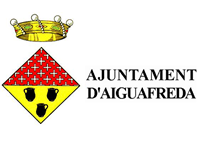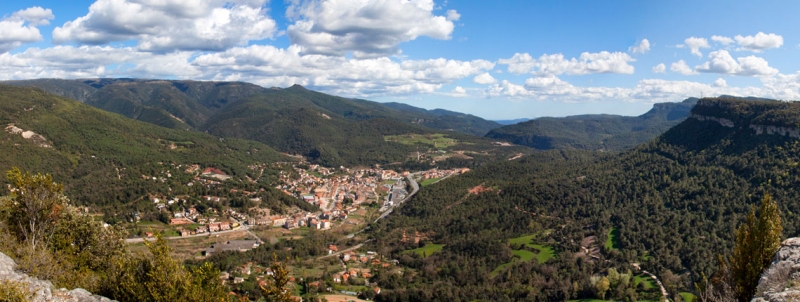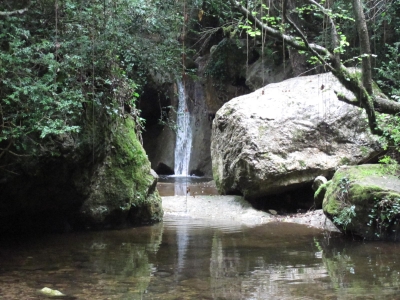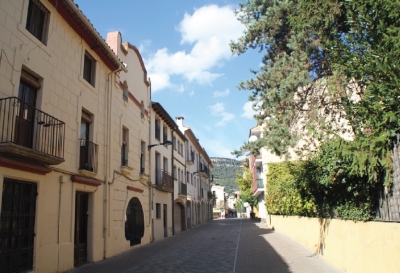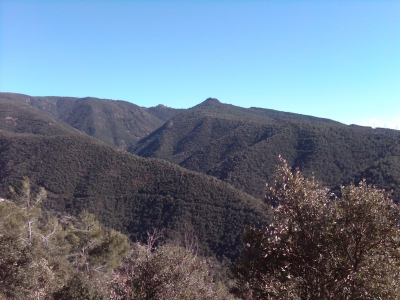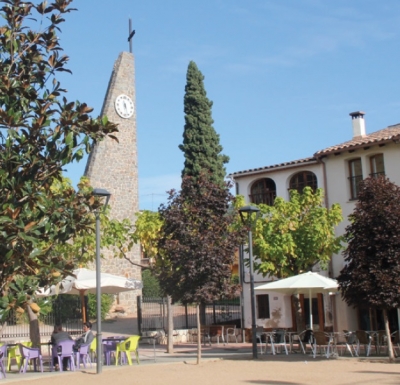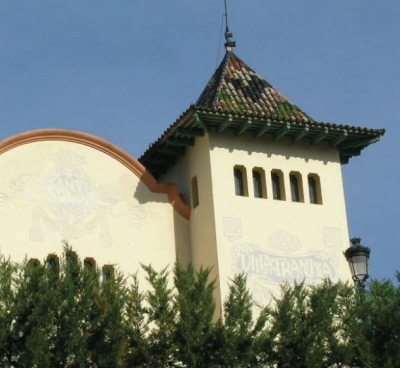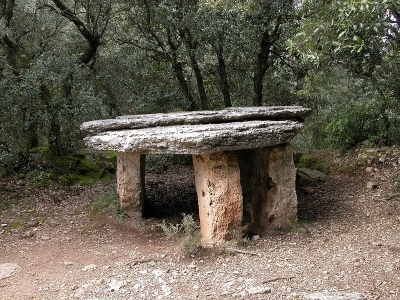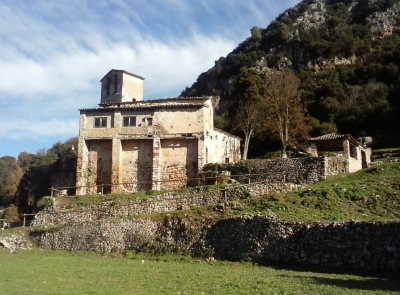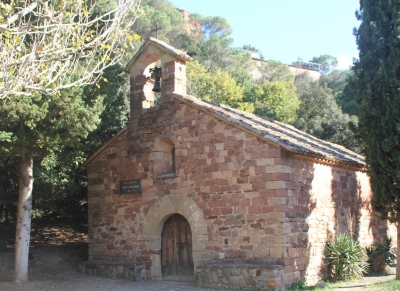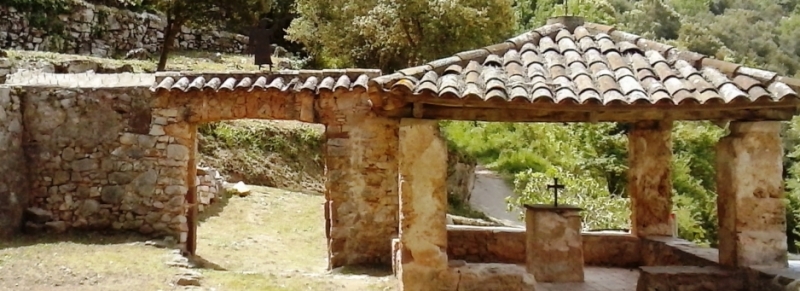- MIDA DEL TEXT |
- | SENSE ESTILS

Visitors Guide
THE VILLAGE
Geography
Aiguafreda is the last municipality in the north of Vallès Oriental although it is also closely bound to Osona. Both Vallès Oriental and Osona are two of the administrative areas (comarques) in which Catalonia is divided.
Aiguafreda is in the north-west Montseny, on the left bank of the Congost river, and it is encompassed by two gullies —Avencó and Martinet. The town is also surrounded by mountains: a crest line going down the Muntanyà and Perafita to the Martinet gully, to the north; Serra de l'Arca and la Calma to the east; Tagamanent, Puig-agut and Montcau —all of them belonging to Serra Madrona— to the south; La Serra de Castellar to the south-west; and finally, to the west there stand Cingles de Bertí Natural Reserve which its primary geographical feature is La Cinglera del Cerdà.
Ecology
Aiguafreda is surrounded by a wonderful countryside that makes our town an enjoyable place to stay. On the one hand, Aiguafreda is close to the Montseny, which is a Catalan National Natural Reserve (since 1987), as well as a recognized UNESCO Biosphere Reserve. On the other hand, the town is not far away from the beautiful cliffs of Els Cingles de Bertí (PEIN since 2002).
Forests cover about the 80% of the region's total area. There are many Aleppo pines (Pinus halepensis) and stone pines (Pinus pinea) throughout the area known as Les Pinedes or Espidenes. At the valley La Vall d'Avencó the main species is the holm oak (Quercus ilex), although we can also find common alders (Alnus glutinosa), willows (Salix) and black poplars (Populus nigra) in Avencó and Martinet gullies, and throughout El Congost.
The geology of the municipality —placed right in the middle of the Catalan Pre-Coastal Range— is dominated by limestone, with a series of marl and sandstone intrusions to the west, and slate and schist to the east, close to a Palaeozoic formation known as La Calma.
Aiguafreda features a continental Mediterranean climate. The average annual temperature in Aiguafreda is 12.7 °C and the average rainfall is around 70 mm per year. The coolest month is January, with an average temperature of 3.7 °C, while the warmest month is July (22.5 °C). October is the rainiest month (84 mm) and February and July are the driest (41 mm).
Economy
Historically textile industry and construction were important sectors in Aiguafreda's economy, although they gradually became less significant by the end of the 20th century. Today, Aiguafreda's economy depends on light industry and services. The service industry is the dominant sector in our town, for it employs more than the 50% of the gainfully occupied population. This composition of the labour force is common in Catalan municipalities, according to the standards of a present-day society.
A place to visit, a place to stay
Aiguafreda offers the best quality of life to the widest number of people, for it features good local shops and services and attractive outdoor spaces. The town is also close to major cities like Barcelona and Vic.
HISTORY
Etymology
The toponym ‘Aiguafreda’ —literally ‘cold water’— appears for the first time in 898, in its latin form (Aquafrigida), in the Sentence of Consecration of Sant Martí del Congost church. The members of the village's first noble family were named after the toponym, as well as their castle, which is known as Castell de Cruïlles nowadays (Nomenclàtor oficial de toponímia major de Catalunya, 2009).
Nomenclator de Catalunya(PDF, 1,38 MB)
Nomenclator de Catalunya
Village History
The village of Aiguafreda is mentioned for the first time in the Sentence of Consecration of Sant Martí del Congost church, one of the key documents to the Catalan Early Middle Ages. However, the present village centre was established in the early modern period, near a smithy (ferreria), recorded for the first time in 1553 andplaced in the ancient communication route from Barcelona to Vic, known as camí ral. This is why that new neighbourhood was called Les Ferreries.
The first church building was built in the current Plaça Major. That was the village’s first step towards its emancipation from the original parish of Sant Martí del Congost. That little building became a parish in 1877, when the Santa Maria d’Aiguafreda church was erected. The present church is also dedicated to Santa Maria and it was consecrated in 1969.
In 1840 it was opened a new road which replaced the camí ral as the main communication route and village axis. Finally, the main road was diverted in 1986 and it bypasses the village since then. That was the epilogue for the close relationship between Aiguafreda, Congost Valley and the north-south communication routes in central Catalonia.
TOURISTIC BROCHURES:
ANNUAL EVENTS AND MARKETS
Cavalcada de Reis (5 January)
This holiday celebrates with a parade the arrival of the Three Kings or Magi, who bring gifts to children on the night before Epiphany –much like Santa Claus with his reindeer. The cavalcada is a very popular holiday in Aiguafreda: people receive the Kings with lavender torches, children craft Chinese lanterns, bonfires are light at the main square and soup would be offered to anyone who wants it. The cavalcada is arranged by the Village Council and the Aiguafreda Committee for Festivals.
Carnestoltes (February / March)
Carnival is a traditional period of fun, feasting and partying. This celebration was revived in the 1980s and nowadays is one of the most popular festivals in the village. Thousands of people from Aiguafreda and neighbouring villages enjoy the fancy-dress parties and parades. This festival is also organized by the Village Council and the Aiguafreda Committee for Festivals.
Caminada d’Aiguafreda (April)
Every year lots of people come and enjoy our countryside during La Caminada (hike). The walk is 20 km long and it is arranged by Els Gafarrons. Amics de la Caminada de Sant Martí de Centelles i Aiguafreda. They also organize La Caminada de Sant Martí in March.
Medicinal plants and herbs market (May)
This spring market organized by the Village Council is the closing activity of the Flowers and Plants Week. The market opens on Saturday, at Plaça Major.
Aplec d'Aiguafreda de Dalt (Ascension Day)
This is the annual religious pilgrimage to Sant Martí d’Aiguafreda de Dalt organized by the Aiguafreda Parish and Els Amics de la Sardana de la Vall del Congost. The pilgrims make their way on foot to the church, carrying a sculpture of Christ on the Cross (El Sant Crist) to celebrate the Ascension of Christ into heaven. The festivity involves a party at which pilgrims drink hot chocolate and dance sardanes –a traditional catalance dance– amid a spring atmosphere.
Corpus Christi (May / June)
The celebration of Corpus Christi was revived in recent years. It used to be one of the most colorful holy days in Aiguafreda for it involved the decoration of streets and squares with floral ornamentation and flower carpets.
Revetlla de Sant Joan (June)
The Nit de Sant Joan on Midsummer’s Eve begins with the arrival of La Flama del Canigó, the torch used to light a large bonfire known as foguera de Sant Joan at Plaça Major. When this bonfire dies out, people from Aiguafreda eat, dance and party at Parc de la Carretera. This celebration is planned by several associations of Aiguafreda.
Aplec de Sant Salvador (August)
Sant Salvador de l’Avencó is a Romanesque chapel of the 12th century. It is the venue for a religious celebration that takes place the first Sunday of August. This celebration starts with a mass and ends dancing sardanes.
La Mare de Déu d’Agost. Summer Festival (15 August)
The feast of the Assumption of Mary was celebrated for the first time in the mid-19th century. Today, the celebration consists of diverse religious and festive activities (dance, open-air cinema, havaneres, etc.) that make our summer bright.
Meeting at Les Alzines d’Avencó (17 August)
This meeting takes place on the last day of the Summer Festival, at Les Alzines d’Avencó. People join up there to have an afternoon snack, dance sardanes and meet again their fellows after summer holidays. It is undoubtedly the most popular event of Aiguafreda Summer Festival.
La Diada. National Day of Catalonia (11 September)
The institutional events that commemorate the 11 September take place in front of the Village Hall. These events include the speeches of the Council key members and the hand over of both our local flag and the national flag (la Senyera) to whom has shown an admirable patriotism. The national flag is the one that has waved in the village hall façade the whole year. This simple but solemn celebration ends with the singing of the Catalan national anthem Els Segadors while the new Senyera is being hoisted up.
Aplec de Tardor d'Aiguafreda de Dalt (September)
People gather at Aiguafreda de Dalt on the last Sunday before the Feast of the Cross to go to mass, dance sardanes and, in recent years, have a midday snack together.
Fira del Tastet (September)
This event has been held since 2002, and it is open to professionals or individuals who want to present their culinary creations and take part in a contest.
Castanyada (October / November)
Around All Saints’ Day, Els Amics de la Sardana “La Vall del Congost” and El Casal Sant Jordi organize a popular castanyada: the people from Aiguafreda roast and eat chestnuts, drink muscatel,eat panellets –the traditional dessert of All Saint’s holiday– with delight, and dance sardanes.
Festa de la gent gran (November)
The elderly people from Aiguafreda and Sant Martí de Centelles have their own celebration since 1974. The festa de la gent gran is a way to thank them for their work and its most outstanding activity is a meal at midday in a local restaurant.
Giants Meeting (November)
The giants couple of Aiguafreda represents the Catalan count Guifré el Pelós, father of Emma, the abbess who consecrated the village’s first parish church, and the baroness of Cruïlles, member of the local noble family that ruled over the village for centuries. During the meeting, our giants welcome gegants, gegantes, gegantons, gegantones and capgrossos arrived from other parts of Catalonia, and then they all dance to the music of gralles and drums.
Winter Festival (8 December)
This festival takes place on 8th December, according to the celebration of the Immaculate Conception of the Virgin Mary, patron of our parish church. Until the abolition of the military service, the young men who had been called up —colloquially known as quintos— were responsible for organizing the festival activities. Nowadays, the organizers are boys and girls who celebrated their 18th birthday during the year and the Aiguafreda Committee for Festivals. This Winter Festival includes an opening speech, religious celebrations, fairground attractions, and dances.
Christmas Fair. December
Several weeks before 25th December, the streets and squares of Aiguafreda are crowded with stalls of crafts and food that help us to get ready for Christmas.
Pessebre Vivent. December
On Christmas Eve you can see living scenes of the Nativity in the streets of Aiguafreda. The displays end with people meeting at the several bonfires that heat the cold winter night.
Quina de Nadal. 25 December
This is a traditionl draw organized by the local Penya Blaugrana —Barça supporter’s club— since 1990. It is the perfect end for the Christmas dinner.
